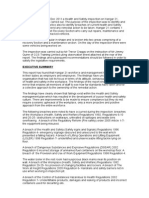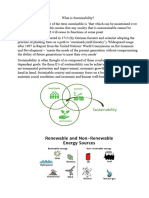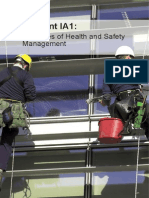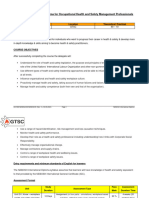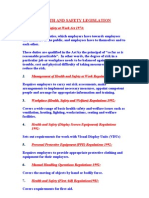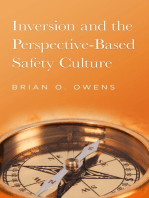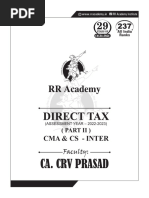Kumbirai Answer Madenyika UB10930SME17914: Safety Engineering
Uploaded by
Kumbirai Answer MadenyikaKumbirai Answer Madenyika UB10930SME17914: Safety Engineering
Uploaded by
Kumbirai Answer MadenyikaSafety Engineering 2010
Kumbirai Answer Madenyika
UB10930SME17914
ENGINEERING SAFETY
Kumbirai A Madenyika Page 1
Safety Engineering 2010
CONTENTS
1 Term----------------------------------------------------------------------------3
2 Introductions------------------------------------------------------------------4
3 Importance of safety and health for Engineers-----------------------5
4 Identification of hazards----------------------------------------------------5
5 Control measures-------------------------------------------------------------8
6 Safety Management of safety----------------------------------------------9
7 Management of risks --------------------------------------------------------10
8- Monitoring performance----------------------------------------------------10
9 Conclusions---------------------------------------------------------------------11
10 Bibliographies ----------------------------------------------------------------11
Kumbirai A Madenyika Page 2
Safety Engineering 2010
SAFETY FOR ENGINEERS
Terms
-OSHAS: occupational health and safety management system
-HAZOP: Hazards and operability studies
-FMEA: Failure mode effect analysis
-FTA: Fault tree analysis
-ETA: Event tree analysis
-PPE: Personal protective equipments
-Compliance: Conforming to safety standards
-Accident: Unusual, unexpected and unintended external action which occurs at any
time, at any place.
-Hazard: anything with a potential to cause harm to property, people and environment
-Engineers: A professional practitioners of any engineering discipline.
-Risks: The quantifiable likelihood of loss or less-than-expected returns.
-OHSAS-Occupational health and safety advisory service;
-OHSAS 1800-1991- occupational health and safety management system
-Obvious hazard
-Concealed hazard-
-Developing hazard-
-Transient hazard-
-NOSA- National Occupational Safety Association
-ISO-international standard organization
-ISO 14001-2004
-JHA- Job hazard analysis.
Kumbirai A Madenyika Page 3
Safety Engineering 2010
-FTA-Freight transport association
-WHAT IF? CHECKS-
PHA- Potentially hazardous asteroids
MORT- Management oversight risk Tree
STEP- Standard for the Exchange of Product Model Data (ISO 10303)
INTRODUCTION
Engineers to today face a lot of safety hazards and risks daily, we have them as
mechanical, electrical, chemical, transport and other related incident such as working in
confined spaces height, operation a few to mention. We are concerned very much with
safety issues because we are the teachers, leaders and workers of industry today and
the future & safety, health, and loss control and prevention is of paramount concern I
our industry. Several industrial groups are encouraging members to have continuous
improvement in their procedures, practices and activities to minimize hazards & state
and federals have outlined legislations improvements for the safety of both employees.
As well safety engineers are to take charge in ensuring that companies follow detailed
steps in ensuring adequate training, comprehensive operating procedures, thorough
analysis of process hazard and accident investigation, proper maintenance of facilities,
well developed emergency plans and self audit for compliance.
Production safety management and its hazards and various engineering and
administrative control will be my major focus in this document. Accidents and hazards at
work have resulted into loss of property, business interruption, and loss of skilled and
experienced manpower. The government and firms have lost multi- billion dollars every
year to healthy and safety related issues and most of the causes can be avoided and
risks can e minimized.
Just to mention but a few MINING EIN News states that only the rescue operation of
the Copiapo Mine accident which happened in Chile according to was estimated to have
cost the mine over 20 million US dollars and two lives. There were 4 explosion at the
Pike River Mine of which they haven’t come up with the cost of coming back into
business according to Radio New Zealand today 3 December 2010 the Chairman of
Pike River Coal John Dow said he does not know how long it will take and how much it
will cost to come back in business and it is still having 29 dead men inside the mine up
to now. Just 3 days after the Pike River Mine disaster there was another disaster in
Southern west China when the Coal mine flooded. Besides production and
manufacturing industries according to Bureau of Labor Statistics, we also have 24%
of the accident happening in retail trades this basically shows why Safety Engineering is
required to minimize the cost and lives lost due Health and safety related issues as
suggested by OHSAS in www.ohsas.org
Kumbirai A Madenyika Page 4
Safety Engineering 2010
Technological changes have resulted in risks due to inexperience and resistance to
change, operation incompetence and carelessness. With this document we should
remove the doubting questions such as Do I know everything? I think I know everything.
I don’t recognize what I don’t know what I know. What I know is my reality. This
document would want to expand the reality so to clear the doubting elements and all
who are concerned will familiarize with the reality too.
IMPORTANCE OF SAFETY & HEALTHY FOR ENGINEERS
Due to technological changes & increase in transport, communication, electronic tech,
medicine, production and manufacturing industries, there have been also an increase in
Risks referring cropping up of new hazards or developing of new hazards or evolution
of hazards, increase in accidents, new unproven concepts and materials and designs as
well as new healthy impacts.
This is the reason why today’s engineers are called in to put into place health and safety
management. This may not benefit only the firms but also the community so engineers
should be responsible enough because the community may overlook hazards for
current benefits yet in the long run they may be affected. A good company policy states
that there is a very good awareness campaign so that the community may know and
understand the after effects of operations in their area.
Safety engineers are called to initiate the best safety procedures and practices for the
betterment of the product, employees and community by following structures and
regulations set by structured health and safety organizations such as the ISO, 14001,
OHSAS, NOSA and many more, so to observe as many hazards and act upon them
within organizations.
IDENTIFICATION OF HAZARDS
Hazards recognition is of paramount importance in the prevention of accidents with the
industry. By identifying properties and characteristics of hazards it becomes easy to
determine their control and because of technological changes in the industries and the
process modifications which are coming up daily it is also important to updating hazard
identification. The reasons being:
I. the identification of workplace hazards is the first step in the risk management
process.
ii. When a new job, task or activity is introduced\initiated;
iii. When the existing process conditions will have to change
iv. When current standard operating procedures need to be altered;
v. When we plan to modify plant facility or plant layout;
vi. When a new equipment or machine will be installed in the plant site;
vii. When new safety equipment is introduced;
Viii. When replacement of chemical, catalyst or fuel is required;
Kumbirai A Madenyika Page 5
Safety Engineering 2010
ix. When a new product will be produced;
x. When plant expansion project is scheduled;
xi. When after an incident or accident occurred;
xii. When a neighbour plant will be built near the existing chemical plant;
xiii. When safety audits, safety inspection, safety patrol or self-inspection system is
being done;
xiv. When transportation of the hazardous chemicals is required;
xv. When on-site and off-site emergency plans are prepared as per the schedule 11
and 12 of MS and IHC rules 1989 of EPA 1986
To identify hazards you simply would ask questions. Does the task or activity or
situation or event have a potential to harm a person, property or environment and the
system? The second question is What if…? For example what is I drive a vehicle with
faulty brakes? What if someone walks across a construction area without a helmet?
These questions will help you to be thorough in hazard identification.
To help in hazard recognition, hazards are divided into 4 categories that are obvious
hazards, concealed hazards, developing hazard and transient hazards. This has been
explained before in terms. Then it is so important to further categorize the hazards as in
below so to be more accurate.
a) Mechanical;
b) Electrical;
c) Radiation;
d) Substances;
e) Fire and explosion;
f) Toxic release; and
And you will come up with some of the following hazards or more:
a) Slips/falls on the floor level;
b) Falls of persons from heights;
c) Falls of tools, materials, etc, from heights;
d) Inadequate headroom;
e) Hazards associated with manual lifting/handling of tools, material, etc;
f) Hazards from plant and machinery associated with assembly, commissioning,
operation, maintenance, modification, repair and dismantling;
g) Vehicle hazards, covering both on-site transport and travel by road;
h) Fire and explosion;
j) Violence to staff;
k) Substances that may be inhaled;
m) Substances or agents that may damage the eye;
n) Substances that may cause harm by coming into contact with, or being absorbed
through the skin;
q) Harmful energies (for example, electricity, radiation, noise, vibration, etc.);
r) Non-compliance of regulation
Kumbirai A Madenyika Page 6
Safety Engineering 2010
s) Inadequate thermal environment, for example too hot;
t) Lighting levels;
u) Slippery, uneven ground/surfaces; v) Inadequate guard rails or hand rails on stairs;
w) Subcontractors' activities.
Pictures below shows hazards
Kumbirai A Madenyika Page 7
Safety Engineering 2010
CONTROL MEASURES
To control hazards 4 principles have to be followed according to the priority as in a
below
ELIMINATION
SUSTITUTION
ENGINEERING CONTROL
ADMINISTRATIVE
CONTROL
PP
E
Elimination of the hazard is the best option if elimination is not possible then substitution
should be considered.
Engineering control is applied to control hazards by engineering modifications in the
process. The last principle advocates the administrative control by making some
administrative mechanism in the workplace to keep away hazards from human and
work place.
Elimination is the best control measure and it is normally advisable effect it at the
development stages. It is important to consider health and safety when work process is
at the planning stage. For example when purchasing equipment it is encouraged to
consider safety not cost.
Substitution –If material or process is not safe it is wise to search for a safer
alternative. It is a fact that no chemical is considered to be completely safe. It is
important to consider such this as if same material is in two forms let’s say powder and
liquid and if the powder one is giving out dust then let’s use the liquid and if the liquid
one is giving hazardous fumes let’s use powder such considerations are so important
to safety. Other examples of substitution are:
-Less hazardous solvents instead of toxic ones dichloromethane or
fluorochlorohydrocarbon instead of carbon tetrachloride; and toluene, cyclohexane or
ketoses instead of benzene).
-Detergent plus water-cleaning solutions instead of organic solvents;
-Freon instead of methyl bromide chloride as a refrigerant;
-Leadless glasses in the ceramics industry;
-Leadless pigments in paints;
-Ozone in place of Chlorine in swimming pools;
Kumbirai A Madenyika Page 8
Safety Engineering 2010
-Synthetic grinding wheels (such as Aluminium oxide, Silicon carbide) instead of
sandstone wheels
Some of options given in “Environmentally conscious materials and chemical
processing-By Myer Kutz
Engineering control- There are several control measures considered as engineering
control measures such as enclosure, isolation, ventilation, transverse limit switches,
photo sensors level switch, level alarm fire alarms, smoke detectors and many more.
Administration control- Administrative controls limits the duration of working time of
the workers at a hazardous place. Some examples of administrative controls include:
-Changing work schedules (for example, two people may be able to work for four hours
each at a job instead of one person working for eight hours at that job);
-Giving workers longer rest periods or shorter work shifts to reduce exposure time;
Moving a hazardous work process to an area where fewer people will be exposed;
-Changing a work process to a shift when fewer people are working.
-Clear and readable signage are administrative tool for communication and control of
hazards at workplaces (example Fig -15 and16)
-Compliance of regulatory provisions is the best administrative control
-Organization of drills for emergency
-Inclusion of bonus to those who regard safety and follow the safety instructions
-Disclosure of the hazards and risk to civil administration to get help in real emergency
-Inclusion of safety in Corporate Social Responsibility (CSR) and demonstration.
PPE (Personal protective clothing)
PPEs should be used in addition to other control hazards methods. However, if it is
impossible to reduce hazards in spite of the, elimination, substitution, engineering and
administrative controls then PPEs should be used to save lives of workers and even
community.
To help the above control measures to work it some check list should be used and the
examples are:
-Check-list to assess the control measures for personal hygiene First Aid
-Check-list to assess the control measures for hazards control and emergency planning
-Check-list to assess the control measures for personal protective equipments (PPEs)
-Check-list to assess the control measures for general cleanliness
-Check-list to assess the control measures for machine guard
-Check-list to assess the control measures for local exhaust ventilation
SAFETY MANAGEMENT
Industrial safety management aims to minimize chances of risks and accidents by
implementing risk management techniques and safety management operations,
improving standards of health of employees monitoring the operation system and
bolstering safety measures of an industry in general. With the increase in natural
Kumbirai A Madenyika Page 9
Safety Engineering 2010
disasters and rapid industrial growth it has vast importance to learn the skills of safety
management.
We have major styles of management are, pro-active as in working on an issue to
prevent its occurrence and reactive style as in responding to incidents. Though one is
better than the other in both styles communication is so important and the EMS
documents should be communicated openly up and down the hierarchy and the
initiators should make sure a simple language is used to make sure it is understood
from all levels which is what we call formal authorities. And also another way of
sending information can be the informal influence such as peer education and learning
from a tradition or just learning from the reaction of others. Leading is the other taking
responsibility mostly practiced in Japan; all workers are leaders in Japan, doing it for me
and the nation. Legging performance is when some learn from reaction of others.
Above all safety is a responsibility everyone in every organization, so everyone should
play part and takes charge of safety and report any hazard so that it can be acted upon
before any accident or loss occurs.
RISK MANAGEMENT
Risk management is the identification, assessment, and prioritization of risks and
sometimes defined as an effect uncertainty on objectives in ISO31000.
We have a number of assessment methods which are;
i)JHA, ii)FTA, iii)What if? Check. iv)EMEA, v)PHA, vi)HAZOP, vii)MORT, viii)STEP
After assessing the risks the decision to accept risks is called risk acceptance and every
enterprise has a level of risk that it will accept according to the company, association,
industrial standards otherwise it will be impossible to do business.
MONITORING PEFORMANCE
It is important to monitor performance of a system. When we have implemented a
Safety Management System have to review it to see if it is giving good results and as
well were improvement is needed or where alterations are required. There is a
traditional performance monitoring, leading, legging, and using key performance
indicators KPIs.
Above all in an organization safety issues should be communicated at all levels and in a
clear and transparent way. As Engineers safety should be discussed in tool box
meetings, daily, weekly and monthly safety meetings. Written reports, meeting minutes,
routine activity documentation, and permitting should be accessible to everybody if
possible be on bulletin board. Published safety statistics and performance results
should be accessible to every worker for continuous improvements and maintenance.
Changes in system, corrective actions and disciplinary actions should as well be
communicated.
Kumbirai A Madenyika Page 10
Safety Engineering 2010
CONCLUSION
Poor work planning threatens the safety of workers including engineers, it is then
recommended that we observe any hazards seriously and report them to competent
persons to control or respond to the hazard. Any kind of casual approach to safety
issues can become a disaster to workers including the Engineers and loss to the
company.
BIBLIOGRAPHY
-Willie Hummer 1993 - Product Safety Management & Engineering
-American society of safety engineering ISBN 0-939874-90-3
- MINING EIN News
- Radio New Zealand
-www.ohsas.org
- Bureau of Labour Statistics
- MS and IHC rules 1989 of EPA 1986
-Natural disaster and environmental hazards- Josephine Malilay, Dahna Batts, Armin
Ansari, Charles W. Miller, Clive M. Brown
Kumbirai A Madenyika Page 11
You might also like
- TAX - Final Pre-Board With Answer Key Batch Exodus - Encrypted100% (1)TAX - Final Pre-Board With Answer Key Batch Exodus - Encrypted16 pages
- NEBOSH HSE Certificate in Process Safety Management: Course BenefitsNo ratings yetNEBOSH HSE Certificate in Process Safety Management: Course Benefits1 page
- Course FUNDAMENTALS OF ENTREPRENEURSHIP (4) 20180% (1)Course FUNDAMENTALS OF ENTREPRENEURSHIP (4) 20188 pages
- VP EHS Chief Sustainability Officer in ST Louis MO Resume Tom JanicikNo ratings yetVP EHS Chief Sustainability Officer in ST Louis MO Resume Tom Janicik2 pages
- Unsent Message To HSE Professionals in IndiaNo ratings yetUnsent Message To HSE Professionals in India3 pages
- Module 10 - Managing Change and Priorities S1 2024No ratings yetModule 10 - Managing Change and Priorities S1 202432 pages
- Click Here To Download Nebosh Igc Course Details (Nebosh) PDF75% (4)Click Here To Download Nebosh Igc Course Details (Nebosh) PDF2 pages
- Factors That Affect Safety of Tower Crane Installation Dismantling in Construction IndustryNo ratings yetFactors That Affect Safety of Tower Crane Installation Dismantling in Construction Industry11 pages
- Safety Guide For Art Studios: by Thomas Ouimet, CIH, CSPNo ratings yetSafety Guide For Art Studios: by Thomas Ouimet, CIH, CSP25 pages
- ELEMENT 1C: Workplace Welfare Requirements and Specific Workplace IssuesNo ratings yetELEMENT 1C: Workplace Welfare Requirements and Specific Workplace Issues6 pages
- NEBOSH National Diploma in Occupational SafetyNo ratings yetNEBOSH National Diploma in Occupational Safety2 pages
- Safety Management and Safety Culture and Climate Reviews - Executive SummaryNo ratings yetSafety Management and Safety Culture and Climate Reviews - Executive Summary4 pages
- Iosh Working Safely: Sample Trainer PackNo ratings yetIosh Working Safely: Sample Trainer Pack20 pages
- (I) GC2 Element 2 Transport v7 October 2015 Revision100% (1)(I) GC2 Element 2 Transport v7 October 2015 Revision42 pages
- Risk Assessment and Evaluation of Basic Health and Safety Facilities (A Report of Textile Industry Gujrat, Pakistan) (2014)No ratings yetRisk Assessment and Evaluation of Basic Health and Safety Facilities (A Report of Textile Industry Gujrat, Pakistan) (2014)41 pages
- HSE Culture in The Petroleum Industry Lost in TranslationNo ratings yetHSE Culture in The Petroleum Industry Lost in Translation9 pages
- Nebosh Idip Unit C: IC1 Workplace Welfare Requirements and Specific Workplace Issues 2017No ratings yetNebosh Idip Unit C: IC1 Workplace Welfare Requirements and Specific Workplace Issues 201718 pages
- Milestones: Hongkong and Shanghai Banking CorporationNo ratings yetMilestones: Hongkong and Shanghai Banking Corporation3 pages
- Copia de OPERMIN ZAMBIA LTD-MANAGEMENT ACCOUNTS-MARCH 2017No ratings yetCopia de OPERMIN ZAMBIA LTD-MANAGEMENT ACCOUNTS-MARCH 20176 pages
- Certificate of Incorporation: Government of India Ministry of Corporate AffairsNo ratings yetCertificate of Incorporation: Government of India Ministry of Corporate Affairs1 page
- APQP - Product Characteristic Matrix: Supplier Supplier Process Control Safe Launch Plan (SLP)No ratings yetAPQP - Product Characteristic Matrix: Supplier Supplier Process Control Safe Launch Plan (SLP)3 pages
- Demand Analysis: Demand Desire + Ability To Pay + Willingness To Pay Demand Is Relative Term - Price Time PlaceNo ratings yetDemand Analysis: Demand Desire + Ability To Pay + Willingness To Pay Demand Is Relative Term - Price Time Place44 pages
- Implementation of Location Planning at Home Depot-1No ratings yetImplementation of Location Planning at Home Depot-16 pages
- 02 Basics of Accounting and Accounting Equation PDFNo ratings yet02 Basics of Accounting and Accounting Equation PDF11 pages
- Eskom Pension and Provident Fund Vs Brian MolefeNo ratings yetEskom Pension and Provident Fund Vs Brian Molefe20 pages
- Share Contemporary World KCAST For ProofreadingNo ratings yetShare Contemporary World KCAST For Proofreading110 pages
- Get Unlimited Downloads With A Membership: Magyarok Nyelvtani Munkafüzet A1 A2 PDFNo ratings yetGet Unlimited Downloads With A Membership: Magyarok Nyelvtani Munkafüzet A1 A2 PDF2 pages
- Peran Akuntansi Dalam Mewujudkan Good Governance (Studi Pada Dinas Tenaga Kerja Kota Surabaya)No ratings yetPeran Akuntansi Dalam Mewujudkan Good Governance (Studi Pada Dinas Tenaga Kerja Kota Surabaya)20 pages
- Assignment 2: Journal Entry & Ledger PostingNo ratings yetAssignment 2: Journal Entry & Ledger Posting3 pages
- PhibuzZ Business Deck - 20240829 - 012353 - 0000No ratings yetPhibuzZ Business Deck - 20240829 - 012353 - 00008 pages
- TAX - Final Pre-Board With Answer Key Batch Exodus - EncryptedTAX - Final Pre-Board With Answer Key Batch Exodus - Encrypted
- NEBOSH HSE Certificate in Process Safety Management: Course BenefitsNEBOSH HSE Certificate in Process Safety Management: Course Benefits
- Falls from Height: A Guide to Rescue PlanningFrom EverandFalls from Height: A Guide to Rescue Planning
- VP EHS Chief Sustainability Officer in ST Louis MO Resume Tom JanicikVP EHS Chief Sustainability Officer in ST Louis MO Resume Tom Janicik
- Module 10 - Managing Change and Priorities S1 2024Module 10 - Managing Change and Priorities S1 2024
- Click Here To Download Nebosh Igc Course Details (Nebosh) PDFClick Here To Download Nebosh Igc Course Details (Nebosh) PDF
- Factors That Affect Safety of Tower Crane Installation Dismantling in Construction IndustryFactors That Affect Safety of Tower Crane Installation Dismantling in Construction Industry
- Safety Guide For Art Studios: by Thomas Ouimet, CIH, CSPSafety Guide For Art Studios: by Thomas Ouimet, CIH, CSP
- ELEMENT 1C: Workplace Welfare Requirements and Specific Workplace IssuesELEMENT 1C: Workplace Welfare Requirements and Specific Workplace Issues
- Safety Management and Safety Culture and Climate Reviews - Executive SummarySafety Management and Safety Culture and Climate Reviews - Executive Summary
- (I) GC2 Element 2 Transport v7 October 2015 Revision(I) GC2 Element 2 Transport v7 October 2015 Revision
- Risk Assessment and Evaluation of Basic Health and Safety Facilities (A Report of Textile Industry Gujrat, Pakistan) (2014)Risk Assessment and Evaluation of Basic Health and Safety Facilities (A Report of Textile Industry Gujrat, Pakistan) (2014)
- HSE Culture in The Petroleum Industry Lost in TranslationHSE Culture in The Petroleum Industry Lost in Translation
- Nebosh Idip Unit C: IC1 Workplace Welfare Requirements and Specific Workplace Issues 2017Nebosh Idip Unit C: IC1 Workplace Welfare Requirements and Specific Workplace Issues 2017
- Inversion and the Perspective-Based Safety CultureFrom EverandInversion and the Perspective-Based Safety Culture
- Milestones: Hongkong and Shanghai Banking CorporationMilestones: Hongkong and Shanghai Banking Corporation
- Copia de OPERMIN ZAMBIA LTD-MANAGEMENT ACCOUNTS-MARCH 2017Copia de OPERMIN ZAMBIA LTD-MANAGEMENT ACCOUNTS-MARCH 2017
- Certificate of Incorporation: Government of India Ministry of Corporate AffairsCertificate of Incorporation: Government of India Ministry of Corporate Affairs
- APQP - Product Characteristic Matrix: Supplier Supplier Process Control Safe Launch Plan (SLP)APQP - Product Characteristic Matrix: Supplier Supplier Process Control Safe Launch Plan (SLP)
- Demand Analysis: Demand Desire + Ability To Pay + Willingness To Pay Demand Is Relative Term - Price Time PlaceDemand Analysis: Demand Desire + Ability To Pay + Willingness To Pay Demand Is Relative Term - Price Time Place
- Implementation of Location Planning at Home Depot-1Implementation of Location Planning at Home Depot-1
- 02 Basics of Accounting and Accounting Equation PDF02 Basics of Accounting and Accounting Equation PDF
- Get Unlimited Downloads With A Membership: Magyarok Nyelvtani Munkafüzet A1 A2 PDFGet Unlimited Downloads With A Membership: Magyarok Nyelvtani Munkafüzet A1 A2 PDF
- Peran Akuntansi Dalam Mewujudkan Good Governance (Studi Pada Dinas Tenaga Kerja Kota Surabaya)Peran Akuntansi Dalam Mewujudkan Good Governance (Studi Pada Dinas Tenaga Kerja Kota Surabaya)











